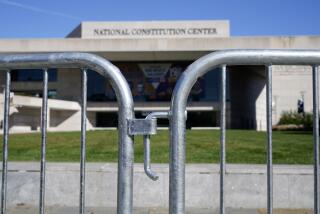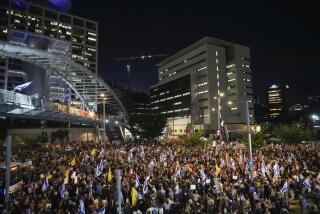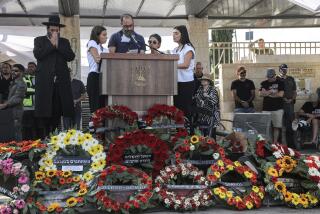Offering Arms for Hostages: An Insider Recalls Another Deal That Soured
It was another time, and the victims bore other names. But the deal was the same: arms for hostages.
Within weeks after war erupted between Iran and Iraq in September, 1980, Tehran was growing desperate for military supplies. The Iranian military had already been thrown into disarray by the political turmoil following the departure of the shah. Known for their close contact with the American military establishment, Iranian officers were finding it difficult to overcome the suspicions of the ayatollahs and the revolutionary guards. The sharp decline in Iran’s military capacities, together with the debilitating factionalism of its post-shah politics, had proved too great a temptation for Baghdad. Iraq invaded, and one of history’s horror stories began to unfold.
Iran’s desperate need for spare parts and other supplies injected a new element into the protracted negotiations to free the 52 Americans then held hostage in Tehran. Signals of a possible “arms-for-hostages” trade came through on several channels.
One of them involved an Iranian national who had served as an agent in earlier sales of F-14 aircraft to the shah’s government. Apparently acting on behalf of Iranian President Abolhassan Bani-Sadr, the man sought unsuccessfully to make contact directly with senior officials of the Carter Administration. A few days after the war began he turned to Mitchell Rogovin, an American attorney with whom the Iranian had dealt previously. At that point the situation became a volatile mixture of international intrigue and domestic politics--for Rogovin was serving as general counsel in Rep. John B. Anderson’s presidential campaign.
Rogovin immediately came to me as the campaign’s director of policy planning. The accident of Rogovin’s prior acquaintance with the Iranian intermediary presented us with an extraordinary dilemma. To involve the candidate in negotiations regarding the hostages, directly or indirectly, was too dicey to contemplate. Yet if the overture had any substance at all, it had to be brought to President Carter’s attention. With Anderson’s approval we met with Harold Saunders, the assistant secretary of state handling the hostage crisis.
Saunders heard us out and asked the right questions. How could we be sure the agent represented those for whom he claimed to speak? Previous maneuvers to release the hostages had collapsed when contacts in Iran proved incapable of carrying out their commitments. Did this man speak for authorities who could actually deliver the Americans to freedom? Rogovin and I took no position on the merits of the proposed exchange, but we undertook to determine if the approach was valid and reliable.
When we resumed discussions with the Iranian, we pressed for credible evidence that he was authorized to act and that those he represented were in a position to bargain. On the first point, he resolved the question conclusively by communicating with Tehran and producing a detailed inventory of the materiel requested. A lengthy computer print-out provided parts numbers and specifications in such detail that they could only have come from the Iranian air force. Most of the equipment was for F-4 and F-14 aircraft, the mainstays of the Iranian force. The Iranians also wanted Phoenix missiles, the most sophisticated weaponry for the F-14s. We conveyed the parts list to Saunders for review within the government.
On Oct. 5, CIA Director Stansfield Turner briefed Anderson on the war situation and indicated that it would be difficult for the United States to provide Iran anything so potent as the Phoenix missiles. But we inferred that supplying some materiel might not be out of the question.
Meanwhile, we probed for a better sense of the agent’s ability to guarantee results if the United States were willing to meet the request. A series of exchanges, interrupted for communications with Tehran, produced a straightforward offer to fly the hostages to Pakistan or another mutually agreeable location, where the Iranians would pick up a planeload of the most urgently needed supplies. But there was an even more forthcoming offer. To demonstrate their good faith, the Iranians would release Bruce Laingen, the American charge d’affaires, in advance of any deliveries. Rogovin and I reported these developments to the State Department.
Coming as they did in the midst of an intense three-way presidential campaign, these discussions evoked understandable wariness within the Administration. Some senior figures in the White House reportedly dismissed the exercise as an Anderson campaign ploy. We didn’t know of other negotiations then under way, but we had a reciprocal anxiety that the President’s men would somehow contrive to portray our involvement as disrupting other efforts that might have brought the hostages home. We were especially apprehensive when the Administration seemed indifferent to accepting the offer of Laingen’s immediate release, although later reflection showed that it would have been difficult to continue the halting dialogue with presumed moderates in Tehran if the senior diplomat on the scene had been brought out alone. Laingen was being held at the Iranian foreign ministry offices, separated from most of the other hostages, and was a vital American channel inside the country.
When reports of a possible swap of weapons for hostages began to surface in the press, our own suspicions flared. We knew that we were not the source. Bani-Sadr was obviously trying to use the option to bolster his standing in Tehran, and we speculated that Carter might manage to turn the possibility into an “October surprise” with decisive impact on the election. The irony did not escape us that the overture conveyed by the Anderson camp might rescue Jimmy Carter. We worried that, even if the deal went sour and did not save the hostages, our role as message-bearers might be used by Carter against Anderson.
Rogovin and I took out insurance. We confided the facts of the episode to three people--Sens. Jacob K. Javits (R-N.Y.) and Charles McC. Mathias (R-Md.) and John Chancellor of NBC. We trusted them to say nothing until the hostages were safely returned--or unless there were an attempt to make John Anderson a scapegoat by claiming that his associates’ alleged interference had somehow frustrated delicate diplomacy aimed at freeing the hostages.
We now know that a number of factors were converging to produce a measured offer by the Carter Administration that ran in a broadly parallel direction to that suggested in the approach we conveyed. In mid-October the President approved a message offering to make available $150 million in aircraft parts and other equipment previously ordered by the shah’s government, but being held in U.S. warehouses. As Carter put it in the debate with Ronald Reagan on Oct. 28, “If the hostages are released safely . . . we would make delivery on those items which Iran owns.”
Strangely, the Iranians never acknowledged the offer.
One hastens to highlight the differences between this 1980 episode and recent commotions. In terms of U.S. attitudes and interests, one of the most important considerations in 1980 was the fact that Iraq was demonstrably the aggressor. Despite the fact that revolutionary guards had seized American hostages, and even after the United States had been provoked into the abortive rescue mission, there persisted the view that long-term strategic considerations warranted giving priority to eventual restoration of relations with Iran as the decisive weight in the region. Although pressures to reach a quick resolution of the hostage crisis were evident, Deputy Secretary of State Warren Christopher and his colleagues managed to protect the negotiations from the distortions of politics. Six years later circumstances have changed markedly. Iraq and the United States have restored diplomatic relations, while it seems as difficult as ever to anticipate who is up and who is down in the faction-ridden regime of the Ayatollah Ruhollah Khomeini. It is Iranian intransigence that has prevented a cease-fire in the war. Today’s hostages are held not by Iran, but by Islamic fundamentalists in Lebanon. The gulf war proceeds toward exhaustion of both parties. The United States is now years into an emphatic policy of never negotiating with terrorists. The stakes have shifted and the calculus has grown more difficult.
Yet in one respect the central tension in policy remains the same. Reasons of state argue for great caution in aligning the United States as an arms supplier to either combatant in the gulf blood bath. And human compassion argues that we lose no opportunity to free those innocent Americans held as pawns by religious fanatics.
However one makes that anguishing trade-off, the governing reality seems to be that it makes no difference. Those who hold the hostages may or may not care whether U.S. arms go to Iran. They want the release of co-religionists now held in Kuwait. And in bargaining with fanaticism, pragmatism has little leverage.
More to Read
Sign up for Essential California
The most important California stories and recommendations in your inbox every morning.
You may occasionally receive promotional content from the Los Angeles Times.










